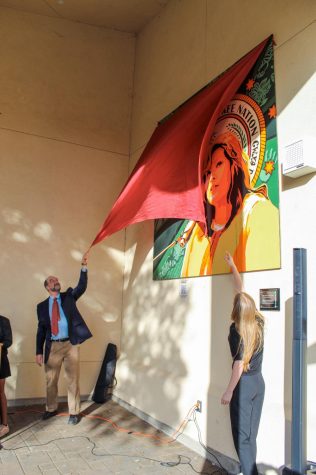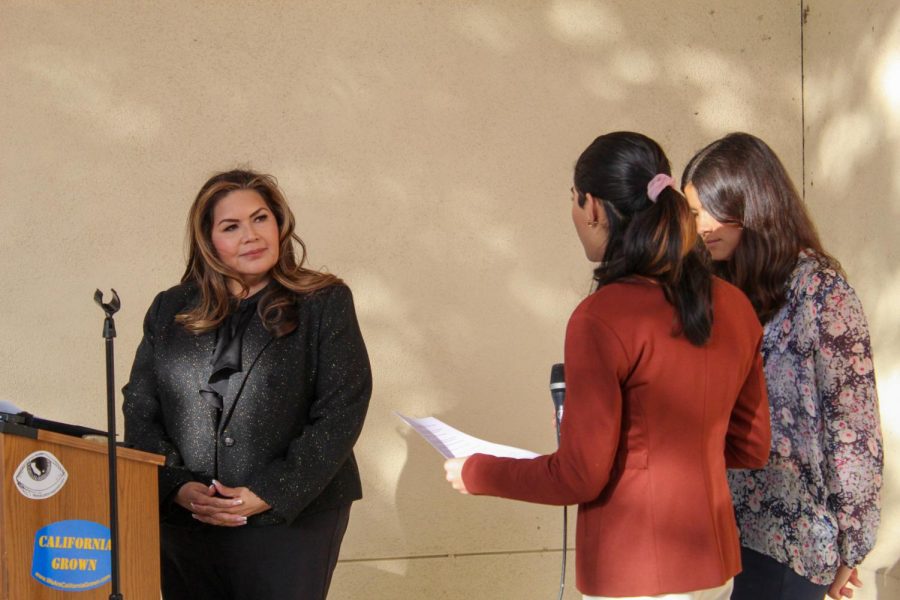Cherokee congressional delegate designee Kimberly Teehee answers questions from the attendees of the Same Moon, Same Stars reveal, facilitated by seniors Hazel Malik and Samantha Lee. Malik was a member of the research team. “I’m thrilled to have contributed to the completion of this mural, and I’m immensely proud of the outstanding quality that we’ve achieved here.”
Unveiling our moon and stars
Social Justice Pathway students reveal mural to support Cherokee delegate to Congress
April 27, 2023
A square of red fabric falls away, revealing a 16-square painting of a Native American woman. The depiction is green, orange, yellow, white, and black to match the Cherokee Nation flag, with each color representing something significant to the tribe.
Student artists based their mural, which covers a wall on the front of the Palo Alto High School 800s building, on a photo of Cherokee congressional delegate designee Kimberly Teehee from when Principal Chief Chuck Hoskin appointed her as the designee in 2019. Around her are the Cherokee Seal, in which each point on the seven-pointed star represents a Cherokee clan; the phrase “Why not now?” referencing a quote from Teehee; and a handprint, to represent missing Cherokee women and children.
Right before history teacher Eric Bloom and senior Kellyn Scheel remove the cover from the mural, with Teehee and a crowd of students, parents, and teachers applauding, senior and project manager Megha Madhabhushi announces the project.
“At the end of the day, we are all one people who fall asleep to the same moon and the same set of stars,” she says. “So without further ado: Same Moon, Same Stars.”
This scene took place at an event held on Monday by a team of seniors in the Social Justice Pathway, in which they revealed their mural project and hosted a speech by Teehee and a virtual message from Hoskin. This project, which stemmed from a junior year assignment, had been in the works for months and aims to spread awareness about the fight to get Teehee seated as a non-voting delegate to Congress, as promised by the Treaty of New Echota.
This 1835 treaty moved the Cherokee tribe West, commonly known as the Trail of the Tears. It also promised the Cherokee Nation a non-voting delegate to Congress, a promise which has gone unfulfilled for nearly 200 years. SJP students learned about this in their history class, and several were inspired to take action to educate other students about it, according to Madhabhushi.
“We thought that a mural would be a really good way to attract the attention in our community because it’s art and it’s in a very central location at our high school,” Madhabhushi said. “That would draw people in and hopefully promote learning.”
Teehee, who gave a speech and hosted a question-and-answer session at the event, said she believes the mural is a valuable tool in promoting knowledge about the Cherokee Nation.
“The more education we get out there, the more awareness, I think the better,” Teehee said. “We’ll have a chance in the future of having less misrepresentation.”
The design of the mural was a collaborative effort between the students and Teehee’s team, according to senior and art lead Kellyn Scheel.
“Throughout this design process, I worked alongside the research team to edit the colors, elements, and layout of the piece as necessary to guarantee a culturally accurate painting, going through around 15 versions before we reached a final design,” Scheel said.

The push to have Teehee seated is important to the Cherokee because of the historic mistreatment they have endured, according to Teehee.
“For decades, US federal government policies attempted to dissolve our government and our ways of life, because we did not have anyone at the highest levels of government to advocate for us,” she said. “Despite all of this historic progress, we still lack the representation that was promised so long ago in our Treaty of New Echota — the representation that our ancestors earned through their blood, sweat and tears.”
Having a delegate in Congress is important because it would show the accountability of the federal government and would increase Native American representation in the government, Teehee said.
“Having a seat at the table, and having a voice where policy discussions and laws are being discussed that impact our community, because it’s not just Cherokee Nation, right?” Teehee said. “We’re really a voice for other tribes in this country.”
In order for the SJP students to create the mural, they did extensive research and became educated on the topic, according to Teehee.
“I feel like I’m a teacher at heart and I love educating, but I’ll tell you what: They educated me when I met with them,” she said. “The amount of history that they knew about Cherokee Nation probably rivals with people who work at Cherokee Nation have on an average day.”
However, some students said this was the first time they had heard about the Cherokee delegate issue.
“I’m definitely, absolutely learning about it for the first time from this,” said senior Ines Legrand, who attended the event. “I don’t think I knew like anything before they [the SJP students] started.”
Madhabhushi attributed the lack of knowledge within the student body and general public to the lack of inclusion of Native American issues in school curricula.
“The biggest thing was noticing how we [SJP students] were learning about this minority group in our history class, but then other history classes weren’t learning about it and were not even learning about anything that was representing a minority group [the Cherokee Nation],” she said.
Legrand agreed that the lack of education about Native Americans in Paly’s curriculum is an issue.
“I feel like first of all, there’s not always indigenous representation within our own history curriculums here,” Legrand said. “[I’m] not going to target PAUSD, because it’s also what happens nationwide, but there’s just not a lot of representation.”
Teehee said she was honored to be part of the mural and is proud of the students who worked on it.
“I think the mural, to me, represents all of the values that I hold dear as a woman, as a Cherokee, as a native, as somebody who’s made a public career in public service advancing the cause of all Native Americans,” she said. “I’ve got enormous respect for the students here.”

